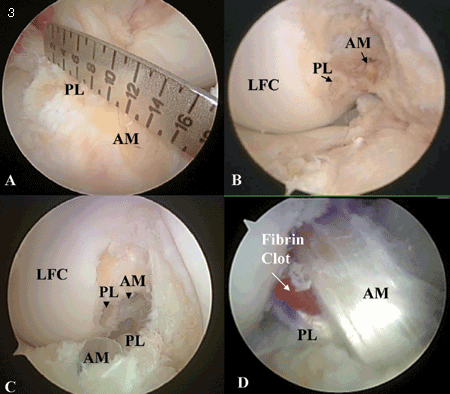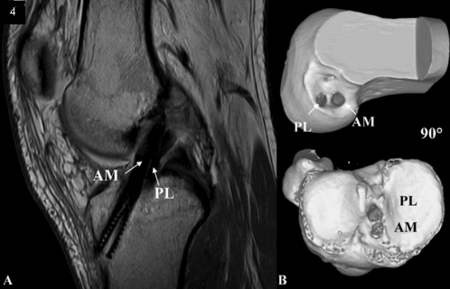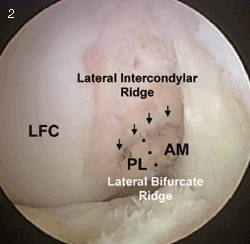Anatomic double-bundle ACL reconstruction
– by Shail M. Vyas, MD; Freddie H. Fu, MD, DSc.(Hon) DPs (Hon)
The core principle of anatomic double-bundle reconstruction is to reproduce the native anatomy of the ACL. Anatomic double-bundle ACL reconstruction continues to gain interest as it has been shown to better restore native kinematics of the knee when compared to traditional single bundle techniques.
The principle of double-bundle ACL reconstruction is fourfold. First and foremost, the native anatomy of the ACL is reproduced. Second, this is done by appropriately identifying the femoral and tibial insertion sites of both the anteromedial (AM) and posterolateral (PL) bundles. Third, the implanted bundles can match the measured dimensions of the patient’s native ligament to individualize ACL reconstruction for that patient. Finally, these bundles can be independently tensioned to act as the native ligament does at varying degrees of knee flexion and rotation.
Technique
The patient is positioned supine on the operating table with the affected knee secured in a leg holder and bent over the end of the table, allowing at least 120° of knee flexion. The contralateral limb is positioned in the high lithotomy position away from the surgical field. We prefer the use of a pneumatic tourniquet.
|
Images: Fu FH |
A three-portal technique is utilized to optimize visualization (Figure 1). First, the high anterolateral portal is created at the intersection between the inferior pole of the patella and the lateral border of the patellar tendon. This portal gives us an excellent “birds-eye” view of the tibial insertion site. Next, under direct visualization, a low central medial portal and an accessory medial portal are both created. The low central medial portal gives an excellent view of the lateral wall of the femoral notch. Using the central medial portal as viewing portal obviates the need for a notchplasty as the whole lateral wall of the notch can be seen from this angle. Furthermore, it allows visualization of the fine anatomical details of the lateral wall of the notch.
Tibial insertion
The tibial insertion site is evaluated with the camera looking down the anterolateral portal. The tibial stump of the ACL is carefully dissected and debrided identifying the AM and PL bundles. Using a cautery device, the center of the AM and center of the PL insertion sites are marked. The length of the total insertion site is measured as well as the size of the individual bundles with an arthroscopic ruler. At least 14 mm are required to accommodate a double-bundle reconstruction. The insertion site diameter for each bundle is the same size that is used when the graft is being prepared to individualize bundle size for each patient.
Femoral insertion
|
|
While directly viewing the lateral wall of the notch through the central medial portal, the femoral insertion site is cleared with a cautery device through the accessory medial portal. Both the AM and PL bundle femoral insertion sites are carefully dissected and the intercondylar ridge is visualized. This ridge runs from superior to inferior — and appears transverse with the knee in the flexed operating position — and marks the most anterior border of the ACL. In the operating position with the knee flexed 90°, the intercondylar ridge is the upper limit of the ACL femoral insertion site. A second ridge, the lateral bifurcate ridge, runs anterior to posterior and is seen as a vertical ridge in the operating position, and marks the boundary between the femoral AM and PL insertion sites (Figure 2). The width of the femoral notch is measured with an arthroscopic ruler. A minimum of 12 mm of notch width is required to accommodate double-bundle reconstruction. Then, the total length of the femoral insertion site is measured. A minimum of 14 mm is required to accommodate two tunnels for double-bundle reconstruction. A pointed awl is then used to mark the center of both the AM and PL tunnels. The femoral PL tunnel is then drilled over a guidepin through the accessory medial portal. This tunnel is drilled with the knee flexed maximally (at least 110°). This knee flexion angle allows for maximum tunnel length and allows the tunnel to exit anterior to the peroneal nerve. The tunnel is drilled to 20 mm by a power acorn reamer, and then by hand to the appropriate depth required for suspensory femoral fixation.
A standard anteromedial skin incision is made over the proximal tibia centered between the anterior tibial crest and the medial tibial crest. We prefer a “tip-directed” tibial tunnel aiming guide to advance our guide pins. The tibial tunnel aiming guide is set to 45° and the tip of the guide is placed in the center of the tibial PL bundle footprint. A guide pin is advanced starting from a more medial position on the anteromedial tibia. The guide is reset to 55° and the tip of the guide is placed in the AM bundle footprint. Starting from a more lateral position on the anteromedial tibial surface, a second guide pin is advanced. On the tibia, the pins should be sufficiently apart such that when the tunnels are drilled, there remains at least a 10 mm bone bridge on the anteromedial tibial surface. The tunnels are then drilled, PL tunnel first, to the pre-determined size based on the diameter of the patient’s tibial insertion sites.
|
|
The AM tunnel can be drilled with the knee at 90° in three ways. It can be drilled through the tibial AM tunnel, through the tibial PL tunnel, or through the accessory medial portal. In our experience, approaching the femoral AM insertion site through the tibial PL tunnel is successful over 60% of the time whereas approaching the femoral AM insertion site through the tibial AM tunnel is successful only approximately 10% of the time. The femoral tunnel is then drilled to a depth of 20 mm and then further hand-drilled per suspensory femoral fixation specifications.
Graft preparation
The soft tissue graft is prepared to meet the anatomical specifications of the individual patient based on pre-measured insertion sites. The PL bundle soft tissue graft is then advanced from the tibial PL tunnel through the femoral PL tunnel. It is then secured on the femoral side with a suspensory fixation device. Next, the AM bundle soft tissue graft is advanced from the tibial AM tunnel through the femoral AM tunnel. It too is secured on the femoral side.
|
|
The graft is then checked for impingement on both the notch and the posterior cruciate ligament. Ideally, with an anatomic ACL reconstruction, there should be no impingement as we have recreated the pre-existing anatomy of the native ACL. With tension on both grafts, the knee is cycled 20 times through a full range of motion, from full extension to maximum flexion. The PL bundle is then fixed in full extension and next, the AM bundle is fixed in 45°. We prefer biointerference screws for our tibial fixation (Figure 3).
|
|
Fibrin clot
Recently, we have added the concept of the fibrin clot to our double-bundle ACL reconstruction to augment biologic healing of the graft. During the operation, 50 to 60 milliliters of blood are drawn from the patient and stirred in a beaker until a clot forms. Part of this clot is sutured within the proximal and distal ends of the soft tissue graft of both bundles. The remainder of the clot is placed between the two reconstructed bundles. Once both bundles are fixed on the femoral side and the PL bundle is fixed on the tibial side, the AM bundle (not yet fixed on tibial side) is pulled apart from the PL bundle with a suture around its waist. A cannula is then introduced through the accessory medial portal and the clot is deposited through the cannula and into the gap created between the bundles. The suture around the AM bundle is then released and the AM bundle is fixed, resulting in a “sandwich” effect of the clot between the two bundles (Figure 4).
Currently, in 30% of all cases, we perform matched anatomic single bundle reconstructions. Indications are a small native femoral or tibial insertion site — less than 14 mm, a severe lateral femoral condyle bone bruise, open physes, significant arthritic changes, a narrow notch, multi-ligamentous knee injury, and a one bundle tear (AM or PL). Understanding the double bundle principle is helpful in placing the single bundle tunnels in the correct anatomic position.
Postoperative care
Postoperatively, the patient’s knee is immobilized in a knee immobilizer locked in full extension. The patient is abled to ambulate with crutches with the braced locked until the first postoperative visit 1 week after surgery. The brace may be removed for ROM exercises at home. The brace can be unlocked after the first postoperative week. The brace is typically discontinued after 6 weeks. The focus of the first 6 weeks is to regain ROM. Subsequently, strengthening protocols are gradually integrated into the postoperative regimen. We prefer a gradual return to activity. Inline activities are permitted between 3 and 6 months. Cutting activities are permitted between 9 and 12 months. A prophylactic ACL brace is utilized for the initial period of return to sport.
Reference:
- Freddie H. Fu, MD, can be reached at The University of Pittsburgh Department of Orthopaedic Surgery, 3471 Fifth Ave., Pittsburgh, PA 15213; 412-605-3203; e-mail: ffu@upmc.edu.





